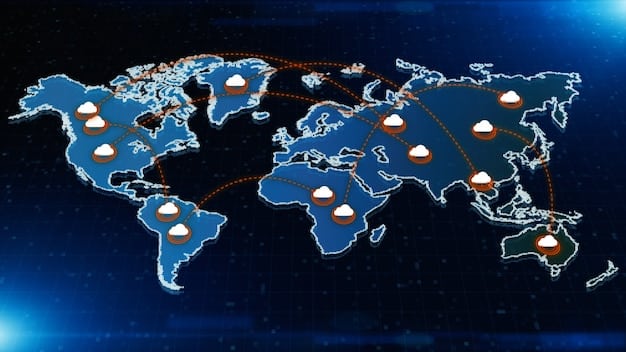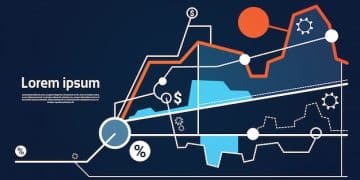Supply Chain Resilience: US Business Strategies for Next 6 Months

For US businesses, strengthening supply chain resilience over the next six months necessitates a multifaceted approach, integrating advanced technology, strategic partnerships, and robust risk management to navigate an increasingly volatile global landscape.
In an era defined by rapid change, from geopolitical shifts to technological advancements, the imperative for Supply Chain Resilience: Strategies for US Businesses to Mitigate Disruptions in the Next 6 Months has never been more pronounced. Companies are seeking tangible, actionable strategies to fortify their operations against the unpredictable nature of today’s global economy, focusing intensely on immediate and near-term preparations.
Understanding the Current Landscape of Supply Chain Disruptions
The global supply chain landscape continues to evolve, presenting both challenges and opportunities for US businesses. Recent events, from natural disasters to geopolitical tensions, have underscored the fragility of traditional supply models, pushing companies to rethink their strategies and embrace a more dynamic approach.
Emerging Threats to Stability
The threats to supply chain stability are multifaceted and ever-changing. Beyond the widely reported issues of capacity shortages and logistical bottlenecks, new vulnerabilities are emerging, demanding proactive mitigation. For instance, the rise of cyberattacks targeting critical infrastructure within supply networks can cripple operations, leading to significant financial losses and reputational damage. Similarly, climate-related events are becoming more frequent and severe, impacting agriculture, transportation, and energy sectors, all of which are foundational to healthy supply chains. Businesses must develop advanced forecasting models that account for these unpredictable yet impactful variables. These models should integrate real-time data from diverse sources, including weather patterns, political instability indicators, and public health alerts, to create a holistic view of potential risks. Predictive analytics, driven by artificial intelligence and machine learning, can help identify subtle patterns and emerging threats that might otherwise go unnoticed.
- Cyber Resilience: Implementing advanced cybersecurity protocols and conducting regular vulnerability assessments across all tiers of the supply chain.
- Climate Adaptation: Developing contingency plans for extreme weather events, including alternative sourcing and logistics routes.
- Geopolitical Sensitivity: Monitoring international relations and diversifying supplier bases to reduce dependency on volatile regions.
The Imperative for Agility
Navigating these disruptions requires an unprecedented level of agility. Companies that can adapt quickly to changing circumstances, whether by re-routing shipments, switching suppliers, or adjusting production schedules, will be the ones that thrive. This agility isn’t just about speed; it’s about flexibility and responsiveness embedded within the very fabric of the supply chain. It means having the structures and mindset in place to pivot effectively, minimizing downtime and maintaining service levels. The ability to make informed decisions rapidly, based on accurate, real-time data, is paramount. This necessitates investment in robust data analytics platforms and the training of personnel to interpret and act on these insights. Supply chain leaders must foster a culture of continuous learning and adaptation, encouraging teams to experiment with new processes and technologies. The goal is to build a system that can absorb shocks and bounce back quickly, turning potential crises into opportunities for innovation.
The current environment necessitates a re-evaluation of traditional just-in-time (JIT) strategies. While JIT offers significant cost efficiencies, its vulnerability to disruptions has become evident. Many US businesses are exploring a “just-in-case” approach for critical components, maintaining strategic stockpiles or diversifying procurement to ensure continuity of supply. This doesn’t mean abandoning JIT entirely, but rather finding a balance that integrates both efficiency and resilience.
This initial assessment of the supply chain landscape sets the stage for more targeted strategies, emphasizing the need for robust planning and proactive measures to mitigate risks effectively in the short to medium term. The next sections will delve into specific strategies that US businesses can employ to build this much-needed resilience.
Enhancing Visibility and Data Analytics for Proactive Decision-Making
In the complex tapestry of modern supply chains, visibility acts as the guiding light, illuminating every node and pathway. Without a clear, real-time understanding of where goods are, what conditions they are facing, and what potential issues might arise, businesses are essentially operating in the dark. Enhancing visibility is not merely about tracking shipments; it’s about creating a comprehensive, data-driven ecosystem that allows for proactive decision-making and rapid response to unforeseen events.
Leveraging Digital Technologies for End-to-End Visibility
The foundation of superior supply chain visibility lies in the strategic adoption of digital technologies. From IoT sensors on containers providing real-time location and environmental data to AI-powered platforms predicting demand fluctuations, technology offers unprecedented insights. Implementing a robust supply chain management (SCM) software suite that integrates with enterprise resource planning (ERP) systems is a critical first step. This integration allows for a unified view of inventory, orders, production schedules, and logistics, breaking down data silos that often hinder effective decision-making. Furthermore, deploying advanced analytics tools can transform raw data into actionable intelligence, enabling companies to identify bottlenecks, optimize routes, and anticipate potential shortages before they escalate into major disruptions. The goal is to achieve end-to-end visibility, encompassing suppliers, manufacturers, distributors, and customers, ensuring that all stakeholders have access to the information they need, when they need it.
- Deployment of IoT devices: Real-time tracking of goods, monitoring of environmental conditions (temperature, humidity), and asset utilization.
- Integrated SCM/ERP Platforms: Centralized data systems for a single source of truth across the supply chain.
- Predictive Analytics & AI: Algorithms that forecast demand, identify potential risks, and suggest optimal mitigation strategies.
Building a Data-Driven Culture
Technology alone is not enough; its effectiveness is amplified by a culture that values and utilizes data. US businesses must invest in training their workforce to become data-literate, enabling them to interpret complex reports, ask pertinent questions, and make data-informed decisions. This involves fostering an environment where data sharing is encouraged, cross-functional teams collaborate on data analysis, and insights are disseminated efficiently throughout the organization. Establishing key performance indicators (KPIs) related to supply chain resilience and regularly reviewing them can help reinforce this data-driven mindset. These KPIs might include supplier lead times, inventory turnover rates, on-time delivery percentages, and recovery time from disruptions. By embedding data analytics into daily operations, companies can move from reactive problem-solving to proactive risk management, continuously optimizing their supply chain for resilience and efficiency.
The next six months present a critical window for US businesses to internalize these practices, moving beyond theoretical discussions to practical implementation. The ability to see clearly across the entire supply chain, and to act decisively based on what is seen, will be a defining characteristic of resilient enterprises in the volatile economic climate. This heightened visibility contributes directly to the ability to identify and respond to risks, as explored in the following section.
Diversifying Sourcing and Regionalizing Production
The globalized supply chains that once promised maximum efficiency have, in recent years, revealed their inherent vulnerabilities. Over-reliance on single-source suppliers or specific geographic regions, while potentially cost-effective, can paralyze operations when disruptions occur. For US businesses, a critical strategy for enhancing resilience in the next six months involves a thoughtful approach to diversifying sourcing and, where feasible, regionalizing production.
Reducing Single Points of Failure
The concept of dual or multi-sourcing is not new, but its urgency has intensified. Identifying alternative suppliers, ideally in different geographic locations, for critical components and raw materials is paramount. This strategy mitigates the risk associated with a single supplier facing production issues, natural disasters, or geopolitical instability. It also introduces healthy competition, potentially leading to better terms and greater flexibility. Beyond simply identifying alternative suppliers, businesses must actively build relationships with them, conducting due diligence to assess their reliability, quality standards, and ethical practices. This might involve small initial orders or trial runs to validate their capabilities before fully integrating them into the supply chain. The goal is to create a robust network of vetted partners who can step in seamlessly when primary sources are compromised.
The diversification extends beyond just direct suppliers to understanding and evaluating the entire sub-tier supply base. Many companies were caught off guard during recent disruptions because their Tier 1 suppliers were reliant on a single, compromised source further down the chain. Mapping out the full supply network, as deeply as possible, is essential to identify and mitigate these hidden single points of failure.
- Supplier Scouting: Proactively identify and qualify multiple potential suppliers for each critical input.
- Geographic Spreading: Ensure alternative suppliers are located in diverse regions to minimize correlated risks.
- Relationship Building: Engage with backup suppliers to maintain readiness and integrate them into contingency plans.
Exploring Nearshoring and Onshoring Opportunities
While full reshoring might not be feasible for all industries or components, nearshoring (moving production closer to the end market, e.g., Mexico or Canada for US businesses) or selective onshoring (bringing production back to the US) presents compelling advantages for resilience. These strategies reduce lead times, minimize transportation costs and risks, and can simplify compliance with evolving trade regulations. Moreover, closer proximity facilitates better communication, quicker resolution of issues, and tighter quality control. US businesses should conduct thorough cost-benefit analyses, factoring in not just direct production costs but also inventory holding costs, shipping delays, geopolitical risks, and the value of enhanced responsiveness to customer demand. Targeted onshoring of highly critical or vulnerable components, even if it entails a higher sticker price, can significantly reduce overall supply chain risk and improve long-term stability.
The conversation around regionalization often includes the development of trusted trade partnerships. Strengthening bilateral relationships with neighboring countries can foster resilient regional supply hubs, benefiting all participants. For US businesses, this could mean exploring enhanced collaboration with partners in North America, leveraging existing trade agreements to build more integrated and secure supply networks.
This shift towards diversification and regionalization represents a strategic recalibration for US businesses, moving away from a sole focus on cost optimization to a more balanced approach that emphasizes resilience and reliability. These measures, while requiring upfront investment, promise substantial returns in terms of stability and competitive advantage in a turbulent global economy.
Implementing Advanced Risk Management and Contingency Planning
In the face of perpetual uncertainty, the ability to anticipate, assess, and mitigate risks is paramount for supply chain continuity. For US businesses, building resilience in the next six months heavily relies on adopting advanced risk management frameworks and developing robust contingency plans that go beyond traditional approaches, integrating predictive capabilities and flexible response mechanisms.
Developing Comprehensive Risk Assessment Frameworks
The first step towards effective risk management is a thorough understanding of the potential threats. This requires moving beyond generic risk lists to create tailored assessment frameworks that consider the unique vulnerabilities of each business’s supply chain. Such frameworks should encompass a broad spectrum of risks:
- Operational Risks: Equipment failure, labor shortages, quality control issues.
- Financial Risks: Supplier bankruptcy, currency fluctuations, sudden cost increases.
- Natural & Environmental Risks: Earthquakes, floods, extreme weather, pandemics.
- Geopolitical & Regulatory Risks: Trade wars, sanctions, new tariffs, policy changes.
- Cybersecurity Risks: Data breaches, ransomware attacks affecting logistics or production systems.
Each potential risk should be evaluated based on its likelihood and potential impact. Heat maps and risk matrices can visually represent these assessments, aiding in prioritization. Furthermore, it’s crucial to map out interdependencies, understanding how a single point of failure in one part of the supply chain can cascade into widespread disruption. This comprehensive mapping should involve not only Tier 1 suppliers but also critical Tier 2 and Tier 3 suppliers, as well as logistic partners and infrastructure. Engaging cross-functional teams from procurement, logistics, IT, finance, and legal is essential to ensure a holistic view of risks and the development of actionable insights. Regular reviews and updates to these frameworks are imperative as the risk landscape is constantly shifting.
Crafting Dynamic Contingency Plans
A risk assessment is only valuable if it leads to actionable contingency plans. These plans should not be static documents but living blueprints that are regularly tested, refined, and communicated throughout the organization. For each identified high-priority risk, specific response procedures should be outlined. This includes:
- Trigger Points: Clearly defined criteria that activate a specific contingency plan.
- Alternative Sourcing Strategies: Pre-negotiated contracts with backup suppliers, ready to be activated.
- Inventory Buffers: Strategic stockpiling of critical components or finished goods for specific periods.
- Logistics Network Alternatives: Pre-identified alternative transportation routes, modes, or carriers.
- Communication Protocols: Clear chains of command and communication strategies for internal teams, suppliers, and customers during a crisis.
Beyond reactive plans, US businesses should also explore scenario planning and war-gaming exercises. Simulating various disruption scenarios allows teams to practice their responses, identify weaknesses in the plans, and build muscle memory for decision-making under pressure. This proactive testing helps to refine response times and improve overall organizational agility during a crisis. The aim is to move from a “react and recover” mindset to one of “anticipate and adapt.”
The integration of these advanced risk management practices and dynamic contingency planning into daily operations will provide US businesses with a robust framework to navigate the inherent uncertainties of global supply chains. It’s about building resilience through foresight and preparation, minimizing the impact of the inevitable disruptions that lie ahead.
Strengthening Supplier Relationships and Collaboration
The notion that a supply chain is only as strong as its weakest link holds true. In the pursuit of resilience, US businesses must recognize that their network of suppliers is not merely a collection of vendors, but a critical extension of their own operations. Deepening these relationships and fostering true collaboration are not just good business practices; they are foundational pillars for mitigating disruptions in the next six months and beyond.
Building Trust and Transparency
Traditional transactional relationships, solely driven by price, are inherently fragile in volatile times. Instead, US businesses should cultivate partnerships built on trust and transparency. This involves sharing information openly, beyond just purchase orders and invoices. Sharing demand forecasts, production schedules, and even potential risk scenarios allows suppliers to better plan their own operations, anticipate challenges, and proactively offer solutions. Regular, open communication channels, including scheduled review meetings and impromptu check-ins, are vital. This allows both parties to address issues before they escalate, coordinate efforts, and align on strategic objectives. When suppliers feel like true partners, invested in the buyer’s success, they are more likely to go the extra mile during a crisis, prioritizing their partner’s needs over those of less engaged customers.
Establishing clear expectations regarding performance, quality, and sustainability can also strengthen these bonds. Implementing supplier performance management systems that provide regular feedback, recognize strong performance, and address areas for improvement fosters a shared commitment to excellence. Trust is a two-way street; businesses must also be reliable and fair partners, ensuring timely payments and upholding contractual agreements.
- Open Information Sharing: Provide suppliers with demand forecasts, production plans, and insights into your business objectives.
- Regular Communication: Establish formal and informal channels for ongoing dialogue and feedback.
- Mutual Problem-Solving: Collaborate on identifying challenges and developing joint solutions.
Co-developing Resilience Strategies
Beyond transparency, true collaboration involves co-developing strategies to enhance mutual resilience. This might include joint investments in technology to improve data sharing, collaborative initiatives to diversify sourcing for common components, or shared risk-sharing agreements. For instance, a US business could work with a key supplier to identify and qualify a backup production facility, or even invest in certain equipment at the supplier’s site to enhance capacity or redundancy. Joint training programs on cybersecurity or risk management can also elevate the capabilities of the entire network.
The concept of “supplier academies” or knowledge-sharing workshops can create a community of practice, where best practices are exchanged and collective resilience is built. This level of partnership moves beyond simple buyer-seller dynamics to create an intertwined ecosystem where the success and stability of one depend on the health of the other. For US businesses looking to mitigate disruptions in the immediate future, actively engaging suppliers in these collaborative resilience-building efforts is not optional; it’s a strategic imperative. The collective strength derived from these fortified relationships will be a significant differentiator in navigating market volatility.
Leveraging Technology for Predictive Analytics and Automation
The rapid evolution of technology offers unprecedented tools for building supply chain resilience. For US businesses aiming to mitigate disruptions in the next six months, the strategic adoption of predictive analytics and automation is no longer a luxury but a fundamental necessity. These technologies empower companies to move from reactive responses to proactive management, anticipating issues before they arise and streamlining operations for greater efficiency and robustness.
The Power of Predictive Analytics
Predictive analytics, fueled by artificial intelligence (AI) and machine learning (ML), can transform vast datasets into actionable foresight. By analyzing historical trends, real-time market data, weather patterns, geopolitical indicators, and even social media sentiment, these systems can forecast demand fluctuations with greater accuracy, predict potential supply shortages, and identify at-risk shipments. For instance, predictive models can anticipate surges in demand for specific products, allowing for proactive inventory adjustments. They can also identify anomalies in supplier performance or logistics networks, signaling potential disruptions weeks or even months in advance. This foresight enables businesses to:
- Optimize Inventory Levels: Reduce overstocking while ensuring sufficient critical components are available.
- Proactive Supplier Engagement: Identify suppliers at risk of disruption and work with them preemptively.
- Strategic Route Planning: Anticipate weather-related delays or geopolitical choke points in logistics.
The insights generated by predictive analytics are crucial for data-driven decision-making, allowing supply chain managers to implement mitigation strategies precisely when and where they are needed most, rather than reacting to events after they have occurred. This shift from reactive to proactive significantly reduces the impact of disruptions.
Embracing Automation for Operational Efficiency
Automation, from robotic process automation (RPA) in administrative tasks to advanced robotics in warehouses, plays a pivotal role in enhancing supply chain resilience. Automation reduces human error, increases operational speed, and improves consistency, all of which are critical during periods of high demand or unforeseen disruption. For example:
- Automated Order Processing: Accelerates order fulfillment, reducing lead times and improving customer satisfaction.
- Robotic Warehouse Systems: Enhance inventory accuracy, optimize storage space, and speed up picking and packing.
- Automated Data Reconciliation: Eliminates manual efforts in comparing invoices with purchase orders, freeing up staff for more strategic tasks.
Beyond tangible operational benefits, automation also frees up human capital from repetitive tasks, allowing employees to focus on more complex, strategic issues such as risk assessment, supplier relationship management, and innovative solutions. In the context of resilience, automated systems can operate continuously, minimizing downtime during labor shortages or other human-centric disruptions.
For the next six months, US businesses should prioritize investments in modular, scalable automation solutions that can be integrated gradually into existing systems. The goal is to create more agile and self-optimizing supply chains that can withstand shocks and recover quickly, all while maintaining high levels of efficiency and service. Leveraging these technologies is not just about keeping pace; it’s about gaining a distinct competitive advantage in an unpredictable global marketplace.
Cultivating a Resilient Organizational Culture and Workforce
Ultimately, the resilience of a supply chain is deeply intertwined with the resilience of the people and culture that manage it. Technology, strategies, and diversified sourcing provide the framework, but it is the human element – adaptable, knowledgeable, and collaborative – that truly brings resilience to life. For US businesses, a strategic focus on cultivating a resilient organizational culture and workforce is critical for navigating the uncertainties of the next six months.
Fostering Adaptability and Agility in Teams
In a constantly shifting landscape, rigid structures and processes can be detrimental. Building an adaptable workforce means empowering employees to think creatively, embrace change, and find innovative solutions to unforeseen problems. This requires a shift from a top-down, command-and-control approach to one that encourages autonomy and distributed decision-making where appropriate. Training programs should focus not just on specific skills but also on critical thinking, problem-solving, and cross-functional collaboration. Developing generalists alongside specialists can provide greater flexibility as roles may need to evolve rapidly during a crisis. Promoting a mindset of continuous learning ensures that the workforce remains agile and responsive to new technologies and evolving market conditions. Regular scenario planning exercises and workshops can help teams practice their responses to hypothetical disruptions, building confidence and fostering a readiness to pivot.
This adaptability extends to leadership as well. Leaders must demonstrate flexibility, transparency, and empathy, guiding their teams through uncertainty while maintaining morale and focus. A culture that encourages experimentation and views failures as learning opportunities will naturally foster greater resilience.
- Cross-Functional Training: Equip employees with diverse skills to handle varied roles during disruptions.
- Empowered Decision-Making: Grant appropriate autonomy to teams and individuals to respond quickly to problems.
- Continuous Learning Mindset: Encourage ongoing skill development and adaptation to new challenges.
Investing in Talent and Knowledge Management
The institutional knowledge within a supply chain organization is an invaluable asset. High employee turnover, especially in critical roles, can expose vulnerabilities. Therefore, US businesses must prioritize talent retention and robust knowledge management systems. This involves not only competitive compensation and benefits but also a positive work environment, clear career development paths, and recognition for contributions. Mentorship programs, internal knowledge bases, and formal documentation of processes can help capture and transfer critical expertise, preventing it from walking out the door with departing employees.
Furthermore, attracting and developing the next generation of supply chain professionals is crucial. This includes investing in university partnerships, internships, and entry-level development programs. A diverse workforce brings a wider range of perspectives and problem-solving approaches, further enhancing resilience.
In the next six months, proactively addressing these human and cultural elements will fortify the entire supply chain. A resilient workforce, equipped with the right mindset and supported by a strong organizational culture, can transform challenges into opportunities, ensuring business continuity and competitive advantage in an ever-changing world. It is the human ingenuity and collaboration that ultimately bridge the gaps left by even the most advanced technological solutions.
| Key Strategy | Brief Description |
|---|---|
| 📊 Enhanced Visibility | Implement digital tools for real-time, end-to-end supply chain data to enable proactive decision-making. |
| 🔄 Diversify Sourcing | Lessen reliance on single sources; explore nearshoring/onshoring for critical components. |
| 🤝 Stronger Partnerships | Build trust and collaborate deeply with suppliers for mutual resilience. |
| 🤖 Tech & Automation | Utilize AI, ML, and automation for predictive insights and operational efficiency. |
Frequently Asked Questions About Supply Chain Resilience
▼
Supply chain resilience is critical due to ongoing global volatility, including geopolitical shifts, climate change impacts, and cyber threats. Building resilience allows US businesses to maintain continuity, minimize financial losses, and protect their market position amidst unpredictable disruptions, ensuring stability and long-term competitiveness.
▼
Technology enhances visibility by using IoT sensors for real-time tracking, integrating SCM and ERP systems for unified data, and deploying AI/ML for predictive analytics. These tools provide end-to-end insights into stock levels, shipments, and potential bottlenecks, enabling proactive decision-making and early issue detection.
▼
Diversifying sourcing means identifying and engaging multiple suppliers, ideally in different geographic regions, for critical components or raw materials. This strategy reduces reliance on single-source suppliers and mitigates risks associated with localized disruptions, enhancing overall supply chain stability and flexibility in procurement.
▼
Yes, nearshoring and onshoring can significantly enhance resilience by reducing lead times, transportation costs, and geopolitical risks. They facilitate closer collaboration with suppliers, improve quality control, and allow for quicker responses to market changes, even if initial costs might be higher due to reduced reliance on distant, cheaper labor.
▼
Organizational culture is paramount because it dictates how employees respond to challenges. A resilient culture fosters adaptability, collaboration, and continuous learning, empowering teams to think creatively and find solutions during disruptions. It ensures that strategies and technologies are effectively utilized by a prepared, flexible workforce.
Conclusion
The journey towards comprehensive supply chain resilience is an ongoing process, not a destination. For US businesses, the next six months represent a critical period to not only implement the strategies outlined but to embed them deeply into the organizational DNA. By prioritizing enhanced visibility through technology, strategically diversifying sourcing and regionalizing production, embracing advanced risk management, fostering strong supplier collaborations, and cultivating a resilient workforce, companies can transform potential vulnerabilities into sources of competitive strength. The imperative is clear: proactive, integrated, and human-centric approaches are essential for navigating the complexities of the global economy, ensuring continuity and sustainable growth in an unpredictable world.







